Yes, well, probably the biggest reason is only 1 team per conference got in the NCAAs 1974 and earlier. Pre-Coach K, we only had 8 NCAAT appearances. But, we also had 4 Final Four appearances, which makes for a pretty healthy winning percentage. Since the tournament expanded to 64 teams in 1985, we've won more national titles and had more Final Final Fours than any other school. So, it makes complete sense why Duke would have the highest winning percentage.
-
FB RecruitingRecruit Search Transfer Portal 2024 Comprehensive Team Ranking 2025 Rivals250 2025 Position Rankings 2025 State Rankings 2025 Team Rankings 2025 JUCO Top 35 2026 Rivals250 2026 Position Rankings 2026 State Rankings 2026 Team Rankings 2027 Rivals250 2027 Position Rankings 2027 State Rankings FB Team Rankings FAQ
Colleges
- American Athletic
- Atlantic Coast
- Big 12
- Big East
- Big Ten
- Colonial
- Conference USA
- Independents (FBS)
- Junior College
- Mountain West
- Northeast
- Pac-12
- Patriot League
- Pioneer League
- Southeastern
- Sun Belt
- Army
- Charlotte
- East Carolina
- Florida Atlantic
- Memphis
- Navy
- North Texas
- Rice
- South Florida
- Temple
- Tulane
- Tulsa
- UAB
- UTSA
- Boston College
- California
- Clemson
- Duke
- Florida State
- Georgia Tech
- Louisville
- Miami (FL)
- North Carolina
- North Carolina State
- Pittsburgh
- Southern Methodist
- Stanford
- Syracuse
- Virginia
- Virginia Tech
- Wake Forest
- Arizona
- Arizona State
- Baylor
- Brigham Young
- Cincinnati
- Colorado
- Houston
- Iowa State
- Kansas
- Kansas State
- Oklahoma State
- TCU
- Texas Tech
- UCF
- Utah
- West Virginia
- Illinois
- Indiana
- Iowa
- Maryland
- Michigan
- Michigan State
- Minnesota
- Nebraska
- Northwestern
- Ohio State
- Oregon
- Penn State
- Purdue
- Rutgers
- UCLA
- USC
- Washington
- Wisconsin
High Schools
- Illinois HS Sports
- Indiana HS Sports
- Iowa HS Sports
- Kansas HS Sports
- Michigan HS Sports
- Minnesota HS Sports
- Missouri HS Sports
- Nebraska HS Sports
- Oklahoma HS Sports
- Texas HS Hoops
- Texas HS Sports
- Wisconsin HS Sports
- Cincinnati HS Sports
- Delaware
- Maryland HS Sports
- New Jersey HS Hoops
- New Jersey HS Sports
- NYC HS Hoops
- Ohio HS Sports
- Pennsylvania HS Sports
- Virginia HS Sports
- West Virginia HS Sports
ADVERTISEMENT
You are using an out of date browser. It may not display this or other websites correctly.
You should upgrade or use an alternative browser.
You should upgrade or use an alternative browser.
50 Greatest Programs of All-Time (Updated Through 2021)
- Thread starter dukedevilz
- Start date
Yes, well, probably the biggest reason is only 1 team per conference got in the NCAAs 1974 and earlier. Pre-Coach K, we only had 8 NCAAT appearances. But, we also had 4 Final Four appearances, which makes for a pretty healthy winning percentage. Since the tournament expanded to 64 teams in 1985, we've won more national titles and had more Final Final Fours than any other school. So, it makes complete sense why Duke would have the highest winning percentage.
Crazy stat. Only 8 tournament appearances and half turned into FF trips...before K...and by two different head coaches. Not bad. Still didn’t think % wise Duke was the best all-time but when you break it down, Duke has made the most out of its limited opportunities in the tournament.
They sure have. Kansas has the worst National Championship game record. A few points here and there our title numbers are very different. It isn’t for a lack of getting to the big game.Crazy stat. Only 8 tournament appearances and half turned into FF trips...before K...and by two different head coaches. Not bad. Still didn’t think % wise Duke was the best all-time but when you break it down, Duke has made the most out of its limited opportunities in the tournament.
They sure have. Kansas has the worst National Championship game record. A few points here and there our title numbers are very different. It isn’t for a lack of getting to the big game.
KU's been a little unlucky in terms of the timing of their runs. 2012 was a bad year for an average KU team to make a run to the title game. Meanwhile, 2010 was a great year for Duke to make a run.
'03 still pisses me off. 12-30 from the FT line and lose by one basket.
When I met Nick Collison several yrs ago, all I could think of was him bricking FTs.
But at least the favor was repaid in 2008. Memphis certainly didn't go 12-30, but they missed the free throws that would've clinched the win. Up 4 with 1:15 left and CDR misses the front end of 1-and-1, up 2 with 16 ticks left he bricks 2 more free throws, 10 ticks left and Rose makes 1 of 2. The rest is history.'03 still pisses me off. 12-30 from the FT line and lose by one basket.
But at least the favor was repaid in 2008. Memphis certainly didn't go 12-30, but they missed the free throws that would've clinched the win. Up 4 with 1:15 left and CDR misses the front end of 1-and-1, up 2 with 16 ticks left he bricks 2 more free throws, 10 ticks left and Rose makes 1 of 2. The rest is history.
Yeah, but that was kind of their MO. Memphis's poor FT shooting was a storyline throughout the tourney.
That KU team wasn't a poor FT shooting team. They just turned into a bunch of Shaqs at the worst possible time.
40% is so bad it almost makes you wonder about point-shaving.
They were shitty as a team, but CDR and Rose were the best FT shooters they had, each at 71%.Yeah, but that was kind of their MO. Memphis's poor FT shooting was a storyline throughout the tourney.
That KU team wasn't a poor FT shooting team. They just turned into a bunch of Shaqs at the worst possible time.
40% is so bad it almost makes you wonder about point-shaving.
Kansas State's program is far superior
He just likes to troll Bc he knows Iowa is below kstate in both sports.
Great effort, really cool stuff! As an Illini fan, I am obviously biased, but I think we are easily a top 20 program of all time and were clearly a top 15 program of all time before our ~15-year dry spell. Even AFTER that, Illinois is in the top 15 in most metrics you would use except for that big elephant in the room - no National Championship.
However, I like to think of all-time rankings as an extension of our impression of programs stretched over every single individual season. For example, if an 8-seed wins the National Championship one year, we give them their due; they are the champs. However, if No. 1 Seed Kansas chokes in the Second Round and No. 2 Seed Michigan State loses in the Sweet Sixteen, our impression doesn't immediately shift to considering that 8-seed as a clear-cut better program than the aforementioned two. That is why I like some metric included that rewards consistency. This can be any of the following:
- AP Top 10/25 Finishes (which you have)
- Weeks in the AP Top 25
- 30-Win Seasons
- 25-Win Seasons
- (More) Points for All-Time Winning Percentage
- Reduction in Points for Losing Seasons
I think it is okay to "duplicate" some things. Just for fun, these would be my subjective rankings of the top ten, so I would obviously be biased toward a system that yielded similar results:
1. Kentucky
2. North Carolina
3. Kansas
4. Duke
5. UCLA
6. Louisville
7. Indiana
8. Villanova
9. Arizona
10. Michigan State
By the way, did you ever see CBS' similar system? I thought it was interesting:
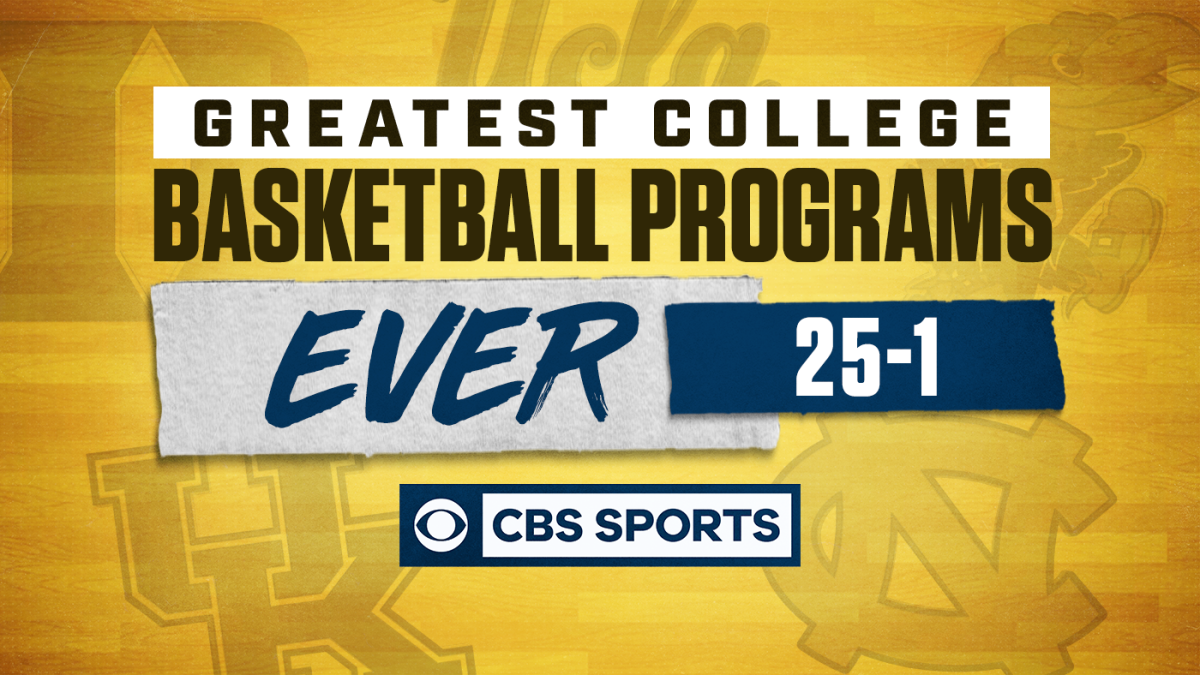
 www.cbssports.com
www.cbssports.com
Again, awesome work, man!
However, I like to think of all-time rankings as an extension of our impression of programs stretched over every single individual season. For example, if an 8-seed wins the National Championship one year, we give them their due; they are the champs. However, if No. 1 Seed Kansas chokes in the Second Round and No. 2 Seed Michigan State loses in the Sweet Sixteen, our impression doesn't immediately shift to considering that 8-seed as a clear-cut better program than the aforementioned two. That is why I like some metric included that rewards consistency. This can be any of the following:
- AP Top 10/25 Finishes (which you have)
- Weeks in the AP Top 25
- 30-Win Seasons
- 25-Win Seasons
- (More) Points for All-Time Winning Percentage
- Reduction in Points for Losing Seasons
I think it is okay to "duplicate" some things. Just for fun, these would be my subjective rankings of the top ten, so I would obviously be biased toward a system that yielded similar results:
1. Kentucky
2. North Carolina
3. Kansas
4. Duke
5. UCLA
6. Louisville
7. Indiana
8. Villanova
9. Arizona
10. Michigan State
By the way, did you ever see CBS' similar system? I thought it was interesting:

The Greatest College Basketball Programs Ever: Ranking the top teams of all time
You know who the top schools are, but can you guess them in the right order? Come look at the top shelf of college hoops
Again, awesome work, man!
Should have an updated table at the conclusion of the 2021 season. Also, I'm thinking of including an all-time starting 5 for each of the 75 teams on my database. Maybe include the school's all-time leading scorer as well as the best team in school history. Obviously this would be way more subjective. But, I think it's worth the undertaking.
Great effort, really cool stuff! As an Illini fan, I am obviously biased, but I think we are easily a top 20 program of all time and were clearly a top 15 program of all time before our ~15-year dry spell. Even AFTER that, Illinois is in the top 15 in most metrics you would use except for that big elephant in the room - no National Championship.
However, I like to think of all-time rankings as an extension of our impression of programs stretched over every single individual season. For example, if an 8-seed wins the National Championship one year, we give them their due; they are the champs. However, if No. 1 Seed Kansas chokes in the Second Round and No. 2 Seed Michigan State loses in the Sweet Sixteen, our impression doesn't immediately shift to considering that 8-seed as a clear-cut better program than the aforementioned two. That is why I like some metric included that rewards consistency. This can be any of the following:
- AP Top 10/25 Finishes (which you have)
- Weeks in the AP Top 25
- 30-Win Seasons
- 25-Win Seasons
- (More) Points for All-Time Winning Percentage
- Reduction in Points for Losing Seasons
I think it is okay to "duplicate" some things. Just for fun, these would be my subjective rankings of the top ten, so I would obviously be biased toward a system that yielded similar results:
1. Kentucky
2. North Carolina
3. Kansas
4. Duke
5. UCLA
6. Louisville
7. Indiana
8. Villanova
9. Arizona
10. Michigan State
By the way, did you ever see CBS' similar system? I thought it was interesting:

The Greatest College Basketball Programs Ever: Ranking the top teams of all time
You know who the top schools are, but can you guess them in the right order? Come look at the top shelf of college hoopswww.cbssports.com
Again, awesome work, man!
Sorry, just seeing this post now for some reason. I did see Matt Norlander's list, yes. I actually replied to him on Twitter and shared my database. But, no response. Not a huge fan of including NBA draft picks. That measures talent perhaps, but not success on the court. And not a huge fan of weeks ranked, as the final poll seems like the only relevant one to me. Did you see my updated table? I included a few more metrics.
what’s the problem?It seems that even with adjustments that your system skews towards programs that have won a lot of conference championships.
what’s the problem?
More conference titles means more chances to build tournament numbers. Since all conferences are not equal in terms of competitive balance, Strong teams in otherwise relatively less competitive conferences had a significant advantage in this regard, especially prior to 1975.
More conference titles means more chances to build tournament numbers. Since all conferences are not equal in terms of competitive balance, Strong teams in otherwise relatively less competitive conferences had a significant advantage in this regard, especially prior to 1975.
Yes, I would agree that it has significantly impacted the numbers. But, conference championships are relevant. The problem is, it's wildly subjective to quantify a conference title, especially when you're making comparisons to different leagues and different years. I might look to adjust that number. I did make conference titles less valuable, however, if that school wasn't ranked, as well as one other conference opponent. Western Kentucky, BYU, Saint Joseph's, and Penn all find themselves in the top 50. Perhaps none of them make it without all of those league titles? Maryland has been adversely impacted by this metric because they played with several dominant schools in the ACC. Only 6 league titles in their history.
It's impossible to have a perfect methodology because not all things are equal, but I think it's necessary to include conference championships.
Yes, I would agree that it has significantly impacted the numbers. But, conference championships are relevant. The problem is, it's wildly subjective to quantify a conference title, especially when you're making comparisons to different leagues and different years. I might look to adjust that number. I did make conference titles less valuable, however, if that school wasn't ranked, as well as one other conference opponent. Western Kentucky, BYU, Saint Joseph's, and Penn all find themselves in the top 50. Perhaps none of them make it without all of those league titles? Maryland has been adversely impacted by this metric because they played with several dominant schools in the ACC. Only 6 league titles in their history.
It's impossible to have a perfect methodology because not all things are equal, but I think it's necessary to include conference championships.
That makes sense. There is always going to be some subjectivity. Thumbs up for the good work.
Yeah, I have messed around a lot with this for fun in Excel in the past, and I think you can only really get a lot from conference championships (regular season or tournament) if you are strictly comparing programs within that conference. The fact that Indiana has 22 Big Ten Championships while Illinois has 17.5 (relax, Michigan fans, just a joke  ) is obviously relevant when comparing Indiana to Illinois ... but how relevant is that disparity when comparing Illinois to Cincinnati? It's incredibly hard to account for where to draw the line here. As has been alluded to, Maryland's basketball history is just an entirely different beast than Purdue's to judge because of the huge effect sharing a conference with North Carolina and Duke has on your ability to win your conference each year. However, when you compare something like weeks in the AP top 25, Maryland's 431 is significantly higher than Purdue's 375.
) is obviously relevant when comparing Indiana to Illinois ... but how relevant is that disparity when comparing Illinois to Cincinnati? It's incredibly hard to account for where to draw the line here. As has been alluded to, Maryland's basketball history is just an entirely different beast than Purdue's to judge because of the huge effect sharing a conference with North Carolina and Duke has on your ability to win your conference each year. However, when you compare something like weeks in the AP top 25, Maryland's 431 is significantly higher than Purdue's 375.
Part of what makes this interesting, though!
Part of what makes this interesting, though!
Imo, adding AP poll finishes is a bad metric, its way too subjective, especially in basketball
Yeah, but the subjectivity balances out. Team X is under ranked one year, over ranked the next.
I should hopefully have the rankings updated sometime this month. Anyone want to make any suggestions on revamping the scoring? Any other metrics to include?
The one I struggle with the most is conference championship points. Currently, conference champs from power 6 conferences automatically receives 5 points. Other conferences are 4 points, unless they were nationally ranked, as well as one other team in the conference. This category is always going to be subjective, unfortunately. If any of you all have any thoughts on this matter, please let me know.
The one I struggle with the most is conference championship points. Currently, conference champs from power 6 conferences automatically receives 5 points. Other conferences are 4 points, unless they were nationally ranked, as well as one other team in the conference. This category is always going to be subjective, unfortunately. If any of you all have any thoughts on this matter, please let me know.
I think, in general, “consistency” and “winning big” should ROUGHLY equal out. Obviously, it’s about winning it all, but any serious ranking should have KU above UCLA even if the Bruins won it all this year. Down a notch, Illinois should come out ahead of Florida in any good ranking regardless of championships. At the same time, Purdue winning a trillion conference titles but making 2 Final Fours must catch up with them. That’s just my take.
I think, in general, “consistency” and “winning big” should ROUGHLY equal out. Obviously, it’s about winning it all, but any serious ranking should have KU above UCLA even if the Bruins won it all this year. Down a notch, Illinois should come out ahead of Florida in any good ranking regardless of championships. At the same time, Purdue winning a trillion conference titles but making 2 Final Fours must catch up with them. That’s just my take.
Nah. No way would any serious ranking have Kansas above UCLA. The only way Kansas is ahead of UCLA, is if you're only counting the past 40 years. This is covering 83 seasons. Let's compare
UCLA
Sweet 16- 35 (+4)
Elite 8- 23 (-1)
Final Four- 19 (+4)
Title Game- 13 (+4)
Championships- 11 (+8)
Kansas
Sweet 16- 31
Elite 8- 24
Final Four- 15
Title Game- 9
Championships- 3
Also, I'm only counting conference championships that happened in 1939 or later. So, 12 of Purdue conference ships aren't included.
Nah. No way would any serious ranking have Kansas above UCLA. The only way Kansas is ahead of UCLA, is if you're only counting the past 40 years. This is covering 83 seasons. Let's compare
UCLA
Sweet 16- 35 (+4)
Elite 8- 23 (-1)
Final Four- 19 (+4)
Title Game- 13 (+4)
Championships- 11 (+8)
Kansas
Sweet 16- 31
Elite 8- 24
Final Four- 15
Title Game- 9
Championships- 3
Also, I'm only counting conference championships that happened in 1939 or later. So, 12 of Purdue conference ships aren't included.
I agree with dismissing the “Only part of the resume counts” argument.
Here are the rankings thru 2021. Teams 1-17 all stayed the same.
Biggest jumps
Baylor: 80th to 59th
Gonzaga: 32nd to 25th
Alabama: 71st to 65th
Oregon: 52nd to 48th
Houston: 39th to 36th
I forgot to include Holy Cross's 11 seasons with a .800+ winning percentage, so they moved up, too. But, that was because of a previous omission. Also, previously didn't have Weber State on the list. Never counted their numbers. They came in at #73.
Still thinking about tinkering the conference title numbers.
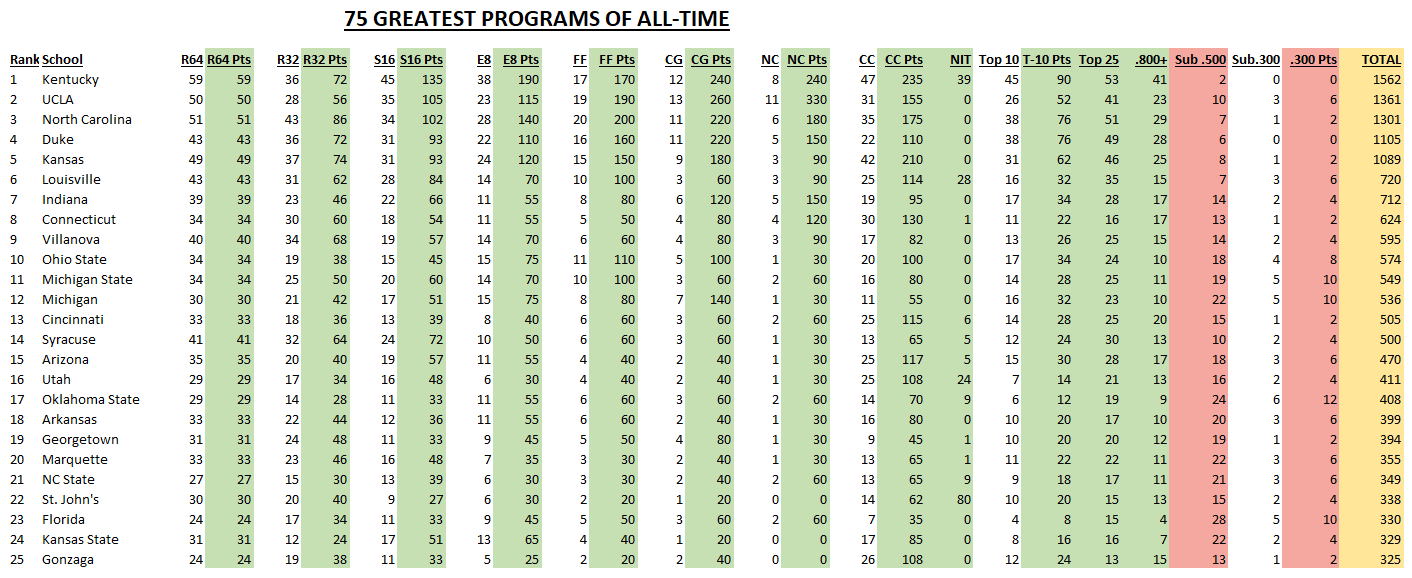
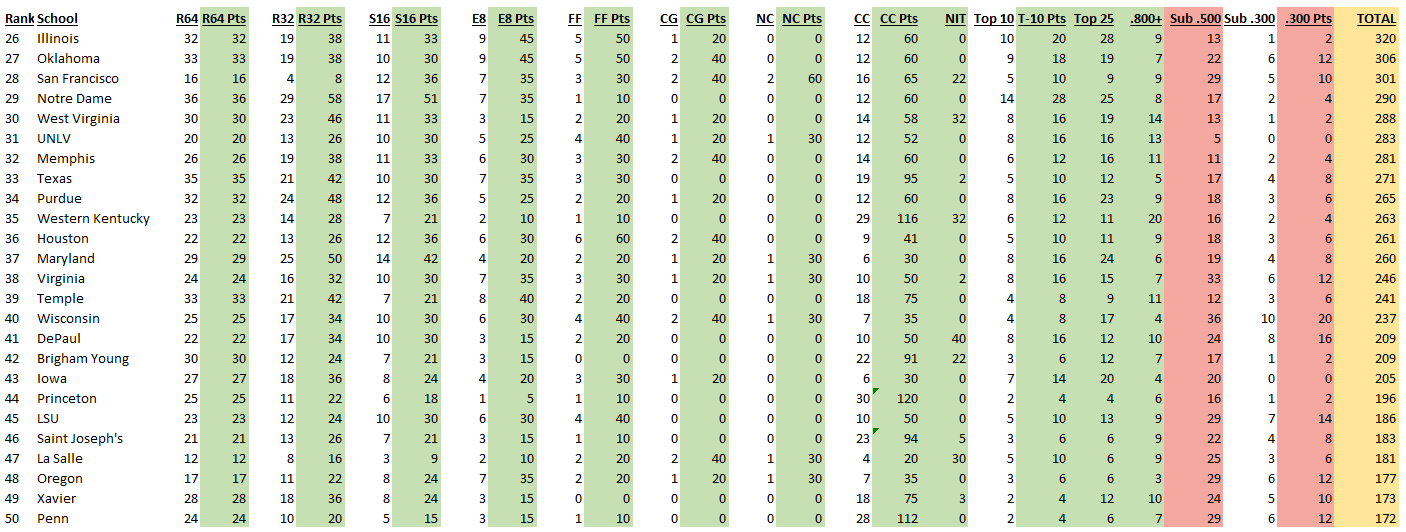
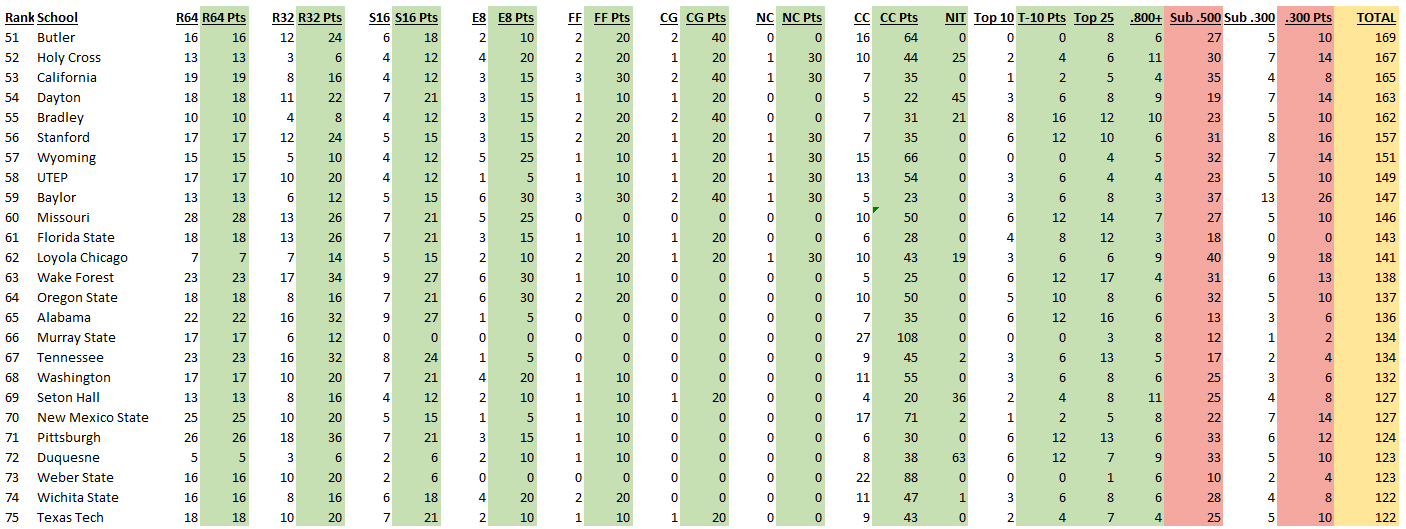
Biggest jumps
Baylor: 80th to 59th
Gonzaga: 32nd to 25th
Alabama: 71st to 65th
Oregon: 52nd to 48th
Houston: 39th to 36th
I forgot to include Holy Cross's 11 seasons with a .800+ winning percentage, so they moved up, too. But, that was because of a previous omission. Also, previously didn't have Weber State on the list. Never counted their numbers. They came in at #73.
Still thinking about tinkering the conference title numbers.



New Rankings By Conference:
A10:
1. St. Joe's (46th nationally)
2. La Salle (47th nationally)
3. Dayton (54th nationally)
4. Duquesne (72nd nationally)
AAC:
1. Cincinnati (13th nationally)
2. Memphis (32nd nationally)
3. Houston (36th nationally)
4. Temple (39th nationally)
5. Wichita State (74th nationally)
ACC:
1. North Carolina (3rd nationally)
2. Duke (4th nationally)
3. Louisville (6th nationally)
4. Syracuse (14th nationally)
5. NC State (21st nationally)
6. Notre Dame (29th nationally)
7. Virginia (38th nationally)
8. Florida State (61st nationally)
9. Wake Forest (63rd nationally)
10. Pittsburgh (71st nationally)
Big 12:
1. Kansas (5th nationally)
2. Oklahoma State (17th nationally)
3. Kansas State (24th nationally)
4. Oklahoma (27th nationally)
5. West Virginia (30th nationally)
6. Texas (33rd nationally)
7. Baylor (59th nationally)
8. Texas Tech (75th nationally)
Big East:
1. UConn (8th nationally)
2. Villanova (9th nationally)
3. Georgetown (19th nationally)
4. Marquette (20th nationally)
5. St. John's (22nd nationally)
6. DePaul (41st nationally)
7. Xavier (49th nationally)
8. Butler (51st nationally)
9. Seton Hall (69th nationally)
Big Sky:
1. Weber State (73rd nationally)
Big Ten:
1. Indiana (7th nationally)
2. Ohio State (10th nationally)
3. Michigan State (11th nationally)
4. Michigan (12th nationally)
5. Illinois (26th nationally)
6. Purdue (34th nationally)
7. Maryland (37th nationally)
8. Wisconsin (40th nationally)
9. Iowa (43rd nationally)
CUSA:
1. Western Kentucky (35th nationally)
2. UTEP (58th nationally)
Ivy:
1. Princeton (44th nationally)
2. Penn (50th nationally)
MVC:
1. Bradley (55th nationally)
2. Loyola Chicago (62nd nationally)
MWC:
1. UNLV (31st nationally)
2. Wyoming (57th nationally)
OVC:
1. Murray State (66th nationally)
PAC 12:
1. UCLA (2nd nationally)
2. Arizona (15th nationally)
3. Utah (16th nationally)
4. Oregon (48th nationally)
5. California (53rd nationally)
6. Stanford (56th nationally)
7. Oregon State (64th nationally)
8. Washington (68th nationally)
Patriot:
1. Holy Cross (52nd nationally)
SEC:
1. Kentucky (1st nationally)
2. Arkansas (18th nationally)
3. Florida (23rd nationally)
4. LSU (45th nationally)
5. Missouri (60th nationally)
6. Alabama (65th nationally)
7. Tennessee (67th nationally)
WAC:
1. New Mexico State (70th nationally)
WCC:
1. Gonzaga (25th nationally)
2. San Francisco (28th nationally)
3. BYU (42nd nationally)
A10:
1. St. Joe's (46th nationally)
2. La Salle (47th nationally)
3. Dayton (54th nationally)
4. Duquesne (72nd nationally)
AAC:
1. Cincinnati (13th nationally)
2. Memphis (32nd nationally)
3. Houston (36th nationally)
4. Temple (39th nationally)
5. Wichita State (74th nationally)
ACC:
1. North Carolina (3rd nationally)
2. Duke (4th nationally)
3. Louisville (6th nationally)
4. Syracuse (14th nationally)
5. NC State (21st nationally)
6. Notre Dame (29th nationally)
7. Virginia (38th nationally)
8. Florida State (61st nationally)
9. Wake Forest (63rd nationally)
10. Pittsburgh (71st nationally)
Big 12:
1. Kansas (5th nationally)
2. Oklahoma State (17th nationally)
3. Kansas State (24th nationally)
4. Oklahoma (27th nationally)
5. West Virginia (30th nationally)
6. Texas (33rd nationally)
7. Baylor (59th nationally)
8. Texas Tech (75th nationally)
Big East:
1. UConn (8th nationally)
2. Villanova (9th nationally)
3. Georgetown (19th nationally)
4. Marquette (20th nationally)
5. St. John's (22nd nationally)
6. DePaul (41st nationally)
7. Xavier (49th nationally)
8. Butler (51st nationally)
9. Seton Hall (69th nationally)
Big Sky:
1. Weber State (73rd nationally)
Big Ten:
1. Indiana (7th nationally)
2. Ohio State (10th nationally)
3. Michigan State (11th nationally)
4. Michigan (12th nationally)
5. Illinois (26th nationally)
6. Purdue (34th nationally)
7. Maryland (37th nationally)
8. Wisconsin (40th nationally)
9. Iowa (43rd nationally)
CUSA:
1. Western Kentucky (35th nationally)
2. UTEP (58th nationally)
Ivy:
1. Princeton (44th nationally)
2. Penn (50th nationally)
MVC:
1. Bradley (55th nationally)
2. Loyola Chicago (62nd nationally)
MWC:
1. UNLV (31st nationally)
2. Wyoming (57th nationally)
OVC:
1. Murray State (66th nationally)
PAC 12:
1. UCLA (2nd nationally)
2. Arizona (15th nationally)
3. Utah (16th nationally)
4. Oregon (48th nationally)
5. California (53rd nationally)
6. Stanford (56th nationally)
7. Oregon State (64th nationally)
8. Washington (68th nationally)
Patriot:
1. Holy Cross (52nd nationally)
SEC:
1. Kentucky (1st nationally)
2. Arkansas (18th nationally)
3. Florida (23rd nationally)
4. LSU (45th nationally)
5. Missouri (60th nationally)
6. Alabama (65th nationally)
7. Tennessee (67th nationally)
WAC:
1. New Mexico State (70th nationally)
WCC:
1. Gonzaga (25th nationally)
2. San Francisco (28th nationally)
3. BYU (42nd nationally)
I don't think OP gets enough credit around here. He keeps us properly informed and makes it super easy to understand.
What's a proper sports forum without guys like @duckboy33 ?
What's a proper sports forum without guys like @duckboy33 ?
I think some consideration has to be given to the NIT, because of the restriction, that a conference could only have one team in the NCAA tourney, that prevailed until the 1970's. I'm particularly thinking of the year that the Pac (Pac 8, at that time) had UCLA win the NCAA, and USC win the NIT, finishing #1 and #5 in the nation, respectively.Upon further thought, I might consider adding NIT points. I would most likely just throw the numbers in with an existing column. The NIT Champ could get 10 points, for example, which is the equivalent of a Final Four team. Just not a fan of double-dipping for points in the same year. But, I understand the argument when some teams chose to be in the NIT instead of the NCAAs. What do others think about scoring the NIT?
I think some consideration has to be given to the NIT, because of the restriction, that a conference could only have one team in the NCAA tourney, that prevailed until the 1970's. I'm particularly thinking of the year that the Pac (Pac 8, at that time) had UCLA win the NCAA, and USC win the NIT, finishing #1 and #5 in the nation, respectively.
I included NIT points up until 1956. Around that time, elite teams were mostly abandoning the NIT. Perhaps I could include points from 1957-1974, but at a reduced rate.
Last edited:
I don't think OP gets enough credit around here. He keeps us properly informed and makes it super easy to understand.
What's a proper sports forum without guys like @duckboy33 ?
I appreciate it, lurker!
In 1971 UCLA finished #1 and USC finished #5, but USC was not in the NIT. The Pac-8 allowed only their conference champion to participate in any postseason tournament up until 1973.I think some consideration has to be given to the NIT, because of the restriction, that a conference could only have one team in the NCAA tourney, that prevailed until the 1970's. I'm particularly thinking of the year that the Pac (Pac 8, at that time) had UCLA win the NCAA, and USC win the NIT, finishing #1 and #5 in the nation, respectively.
For much of the 1950s and 1960s the NIT was devoid of major conference teams. Most conferences restricted postseason play to only their champion and only in the NCAA tournament, the Missouri Valley being a notable exception. In 1967 the ACC and the Big Eight began letting their 2nd place teams play in the NIT and the other major conferences followed suit over the next few years.
Thank you for the correction.In 1971 UCLA finished #1 and USC finished #5, but USC was not in the NIT. The Pac-8 allowed only their conference champion to participate in any postseason tournament up until 1973.
For much of the 1950s and 1960s the NIT was devoid of major conference teams. Most conferences restricted postseason play to only their champion and only in the NCAA tournament, the Missouri Valley being a notable exception. In 1967 the ACC and the Big Eight began letting their 2nd place teams play in the NIT and the other major conferences followed suit over the next few years.
In 1971 UCLA finished #1 and USC finished #5, but USC was not in the NIT. The Pac-8 allowed only their conference champion to participate in any postseason tournament up until 1973.
For much of the 1950s and 1960s the NIT was devoid of major conference teams. Most conferences restricted postseason play to only their champion and only in the NCAA tournament, the Missouri Valley being a notable exception. In 1967 the ACC and the Big Eight began letting their 2nd place teams play in the NIT and the other major conferences followed suit over the next few years.
Great information! Thanks for sharing.
Here's some more up-to-date information. All-Time Wins and All-Time Winning Percentage.
ALL-TIME WINS
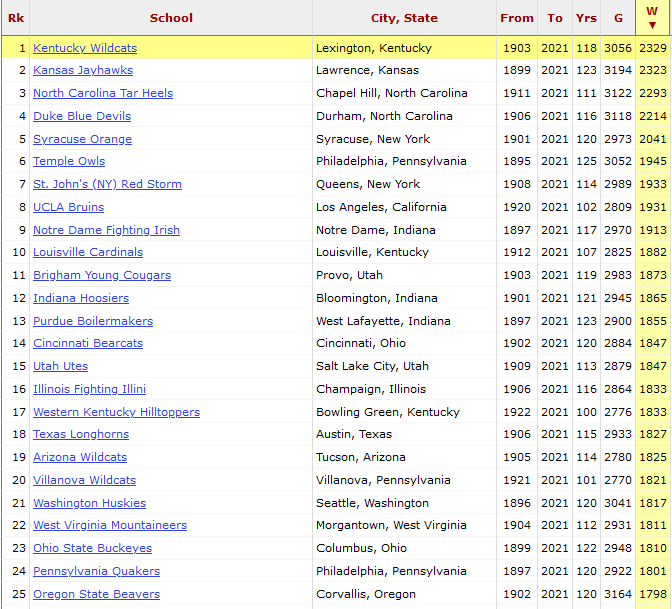
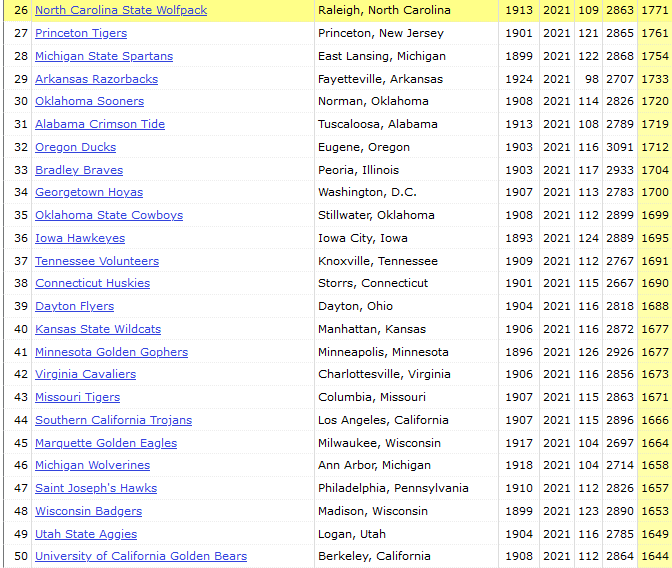
BEST WINNING PERCENTAGE OF ALL-TIME

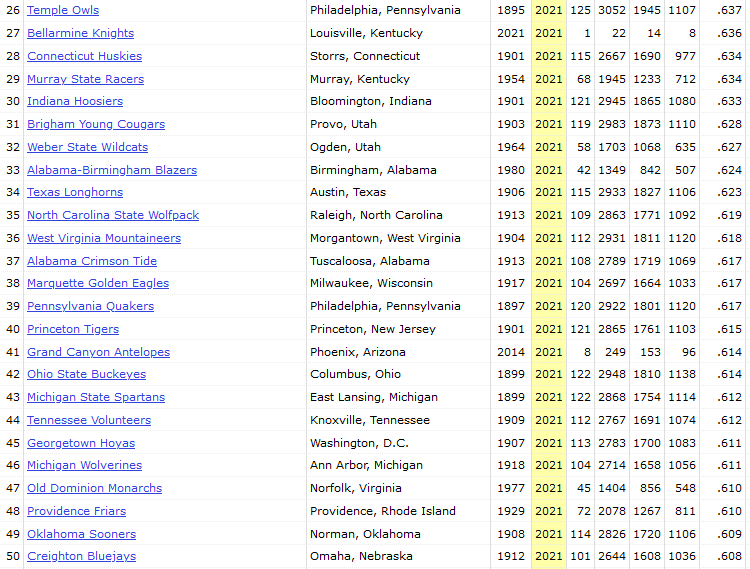
ALL-TIME WINS


BEST WINNING PERCENTAGE OF ALL-TIME


Hmm.....Syracuse = 5th Blueblood.Here's some more up-to-date information. All-Time Wins and All-Time Winning Percentage.
ALL-TIME WINS


BEST WINNING PERCENTAGE OF ALL-TIME


If just wins counted.Hmm.....Syracuse = 5th Blueblood.
75 Greatest Players of All-Time
Most by a school
4: UCLA, North Carolina
3: LSU, Houston
2: Ohio State, Syracuse, Georgetown, Wake Forest, Kansas
Most by a conference (current conference alignment)
ACC: 11
Pac-12: 8
Big East: 7
SEC: 6
Big 10: 5
Big 12: 4
Con-USA: 3
MVC: 2
Atlantic 10: 2
MAC: 2
Patriot League: 2
PAC 12
UCLA
Kareem Abdul-Jabbar
Reggie Miller
Bill Walton
Russell Westbrook
Arizona State
James Harden
California
Jason Kidd
Oregon State
Gary Payton
USC
Bill Sharman
BIG EAST
UConn
Ray Allen
Villanova
Paul Arizin
Georgetown
Patrick Ewing
Allen Iverson
DePaul
George Mikan
Marquette
Dwyane Wade
Providence
Lenny Wilkens
SEC
Auburn
Charles Barkley
Kentucky
Anthony Davis
Georgia
Dominique Wilkins
LSU
Pete Maravich
Shaquille O'neal
Bob Pettit
ACC
North Carolina
Billy Cunningham
Michael Jordan
Bob McAdoo
James Worthy
Syracuse
Carmelo Anthony
Dave Bing
Wake Forest
Tim Duncan
Chris Paul
Miami
Rick Barry
Florida State
Dave Cowens
Louisville
Wes Unseld
BIG 10
Ohio State
John Havlicek
Jerry Lucas
Michigan State
Magic Johnson
Minnesota
Kevin McHale
Indiana
Isiah Thomas
BIG 12
Kansas
Wilt Chamberlain
Paul Pierce
Texas
Kevin Durant
West Virginia
Jerry West
American Athletic
Houston
Clyde Drexler
Elvin Hayes
Hakeem Olajuwon
Cincinnati
Oscar Robertson
MWC
San Diego State
Kawhi Leonard
Atlantic 10
Davidson
Stephen Curry
UMass
Julius Erving
Patriot League
Holy Cross
Bob Cousy
Navy
David Robinson
MVC
Indiana State
Larry Bird
Southern Illinois
Walt Frazier
Horizon
Detroit
Dave DeBusschere
MAC
Eastern Michigan
George Gervin
Bowling Green
Nate Thurmond
WCC
Santa Clara
Steve Nash
San Francisco
Bill Russell
Gonzaga
John Stockton
WAC
Elgin Baylor- Seattle
Conference USA
UTEP
Tiny Archibald
Marshall
Hal Greer
Louisiana Tech
Karl Malone
Big Sky
Weber State
Damian Lillard
MEAC
North Carolina A&T- Sam Jones
SWAC
Grambling State- Willis Reed
Atlantic Sun
Central Arkansas
Scottie Pippen
Not D1:
Robert Parrish, Centenary
Earl Monroe, Winston Salem State
Dennis Rodman, SE Oklahoma State
Dolph Schayes, NYU
Most by a school
4: UCLA, North Carolina
3: LSU, Houston
2: Ohio State, Syracuse, Georgetown, Wake Forest, Kansas
Most by a conference (current conference alignment)
ACC: 11
Pac-12: 8
Big East: 7
SEC: 6
Big 10: 5
Big 12: 4
Con-USA: 3
MVC: 2
Atlantic 10: 2
MAC: 2
Patriot League: 2
PAC 12
UCLA
Kareem Abdul-Jabbar
Reggie Miller
Bill Walton
Russell Westbrook
Arizona State
James Harden
California
Jason Kidd
Oregon State
Gary Payton
USC
Bill Sharman
BIG EAST
UConn
Ray Allen
Villanova
Paul Arizin
Georgetown
Patrick Ewing
Allen Iverson
DePaul
George Mikan
Marquette
Dwyane Wade
Providence
Lenny Wilkens
SEC
Auburn
Charles Barkley
Kentucky
Anthony Davis
Georgia
Dominique Wilkins
LSU
Pete Maravich
Shaquille O'neal
Bob Pettit
ACC
North Carolina
Billy Cunningham
Michael Jordan
Bob McAdoo
James Worthy
Syracuse
Carmelo Anthony
Dave Bing
Wake Forest
Tim Duncan
Chris Paul
Miami
Rick Barry
Florida State
Dave Cowens
Louisville
Wes Unseld
BIG 10
Ohio State
John Havlicek
Jerry Lucas
Michigan State
Magic Johnson
Minnesota
Kevin McHale
Indiana
Isiah Thomas
BIG 12
Kansas
Wilt Chamberlain
Paul Pierce
Texas
Kevin Durant
West Virginia
Jerry West
American Athletic
Houston
Clyde Drexler
Elvin Hayes
Hakeem Olajuwon
Cincinnati
Oscar Robertson
MWC
San Diego State
Kawhi Leonard
Atlantic 10
Davidson
Stephen Curry
UMass
Julius Erving
Patriot League
Holy Cross
Bob Cousy
Navy
David Robinson
MVC
Indiana State
Larry Bird
Southern Illinois
Walt Frazier
Horizon
Detroit
Dave DeBusschere
MAC
Eastern Michigan
George Gervin
Bowling Green
Nate Thurmond
WCC
Santa Clara
Steve Nash
San Francisco
Bill Russell
Gonzaga
John Stockton
WAC
Elgin Baylor- Seattle
Conference USA
UTEP
Tiny Archibald
Marshall
Hal Greer
Louisiana Tech
Karl Malone
Big Sky
Weber State
Damian Lillard
MEAC
North Carolina A&T- Sam Jones
SWAC
Grambling State- Willis Reed
Atlantic Sun
Central Arkansas
Scottie Pippen
Not D1:
Robert Parrish, Centenary
Earl Monroe, Winston Salem State
Dennis Rodman, SE Oklahoma State
Dolph Schayes, NYU
Last edited:
Wow LSU has produced three great players to UK's one.75 Greatest Players of All-Time
Most by a school
4: UCLA, North Carolina
3: LSU, Houston
2: Ohio State, Syracuse, Georgetown, Wake Forest, Kansas
Most by a conference (current conference alignment)
ACC: 11
Pac-12: 8
Big East: 7
SEC: 6
Big 10: 5
Big 12: 4
Con-USA: 3
MVC: 2
Atlantic 10: 2
MAC: 2
Patriot League: 2
PAC 12
UCLA
Kareem Abdul-Jabbar
Reggie Miller
Bill Walton
Russell Westbrook
Arizona State
James Harden
California
Jason Kidd
Oregon State
Gary Payton
USC
Bill Sharman
BIG EAST
UConn
Ray Allen
Villanova
Paul Arizin
Georgetown
Patrick Ewing
Allen Iverson
DePaul
George Mikan
Marquette
Dwyane Wade
Providence
Lenny Wilkens
SEC
Auburn
Charles Barkley
Kentucky
Anthony Davis
Georgia
Dominique Wilkins
LSU
Pete Maravich
Shaquille O'neal
Bob Pettit
ACC
North Carolina
Billy Cunningham
Michael Jordan
Bob McAdoo
James Worthy
Syracuse
Carmelo Anthony
Dave Bing
Wake Forest
Tim Duncan
Chris Paul
Miami
Rick Barry
Florida State
Dave Cowens
Louisville
Wes Unseld
BIG 10
Ohio State
John Havlicek
Jerry Lucas
Michigan State
Magic Johnson
Minnesota
Kevin McHale
Indiana
Isiah Thomas
BIG 12
Kansas
Wilt Chamberlain
Paul Pierce
Texas
Kevin Durant
West Virginia
Jerry West
American Athletic
Houston
Clyde Drexler
Elvin Hayes
Hakeem Olajuwon
Cincinnati
Oscar Robertson
MWC
San Diego State
Kawhi Leonard
Atlantic 10
Davidson
Stephen Curry
UMass
Julius Erving
Patriot League
Holy Cross
Bob Cousy
Navy
David Robinson
MVC
Indiana State
Larry Bird
Southern Illinois
Walt Frazier
Horizon
Detroit
Dave DeBusschere
MAC
Eastern Michigan
George Gervin
Bowling Green
Nate Thurmond
WCC
Santa Clara
Steve Nash
San Francisco
Bill Russell
Gonzaga
John Stockton
WAC
Elgin Baylor- Seattle
Conference USA
UTEP
Tiny Archibald
Marshall
Hal Greer
Louisiana Tech
Karl Malone
Big Sky
Weber State
Damian Lillard
MEAC
North Carolina A&T- Sam Jones
SWAC
Grambling State- Willis Reed
Atlantic Sun
Central Arkansas
Scottie Pippen
Not D1:
Robert Parrish, Centenary
Earl Monroe, Winston Salem State
Dennis Rodman, SE Oklahoma State
Dolph Schayes, NYU
What a stretch. Geeze.
This list is really hard to take.
Similar threads
- Replies
- 90
- Views
- 11K
- Replies
- 43
- Views
- 5K
- Replies
- 33
- Views
- 4K
- Replies
- 14
- Views
- 3K
- Replies
- 71
- Views
- 8K
ADVERTISEMENT
